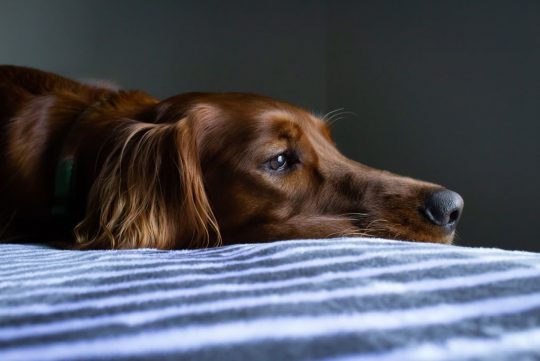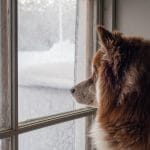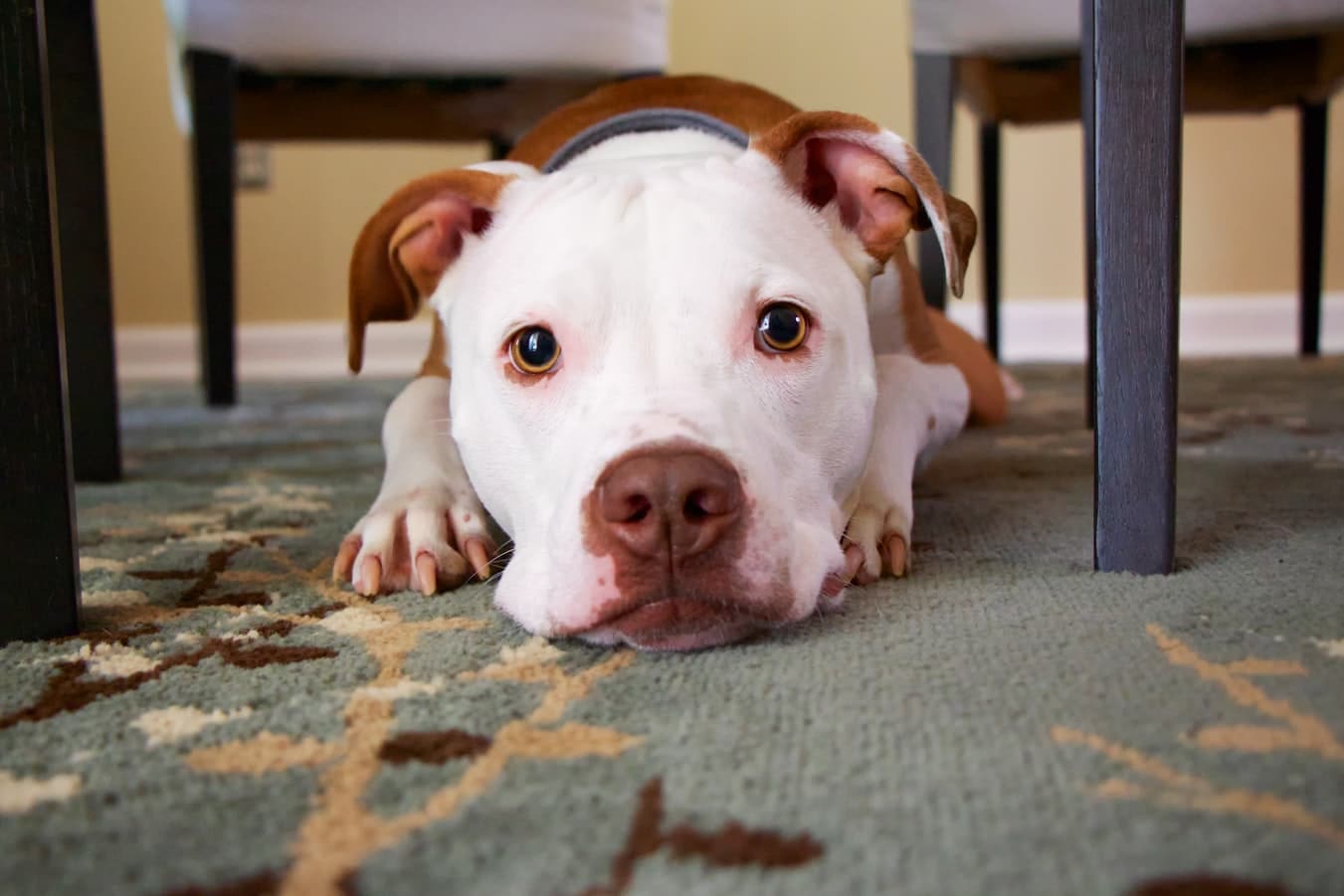Causes
It’s important to find out why your dog is suffering from these problems if you want to help them. There can be many causes for anxiety in dogs, so keep reading for some more information on the topic.

Fear
Fear is a normal response that most mammals feel, but profound fear and anxiety can lead to a very unhappy dog. It’s important to spend time with your dog so you can see what it is that makes your dog scared.
Noises
A common thing that can cause anxiety in dogs is loud noises – for example, fireworks. Your dog has a much stronger sense of hearing than you do, and fireworks can be heard from miles away. Shouting, screaming, thunder or even the hoover are all things that can stress your dog out. Read Chapter 3 for some tips on how you can soothe your anxious dog.
Flashing Lights
Fireworks and thunderstorms really aren’t popular with dogs. It’s not just the loud unexpected bangs, but it’s the sudden flashing lights. Anything sudden may startle your dog, and lights specifically can induce fear in your furry friend.
Unfamiliar People/ Situations
Dogs can get anxious when they’re put in an unfamiliar situation with unfamiliar people. Most dogs hate the vets – because they’re handled in new ways by new people, and are exposed to new sights and smells.
Your dog may also be afraid of strangers. This may be because of past trauma, and it can certainly cause fear in dogs.
Separation
Separation anxiety is common in dogs of all breeds – it’s estimated to affect around 15% of dogs. This can be caused by being abandoned, neglect, having multiple owners – and it will get worse if this carries on throughout your dog’s life.
This type of anxiety is triggered when dogs become upset when you leave them, whether it’s to take the bins out or to go to work.
A sudden absence of the main family member can also cause separation anxiety in dogs. Some dogs never get over the loss of a guardian – and will experience anxiety symptoms for the rest of their lives.
Even the change of a schedule can trigger the development of anxiety. If you work from home or only work short shifts, and suddenly go on to work 12 hour shifts, your dog will notice.
Past Trauma
The way we treat our dogs is detrimental to their wellbeing. If a dog doesn’t get enough love or has suffered abuse and neglect, then he may develop anxiety in the future.
Trauma is damage to the mind that occurs as a result of distressing or disturbing experiences. That can be pretty much anything a dog may find traumatic – the death of a family member, being around arguments and aggression, natural disasters and abuse are all things that can traumatize a dog.
Dogs that have spent a lot of time in a shelter for a long time may also develop anxiety symptoms in later life. This can also lead to separation anxiety.
Genetics
Sometimes, anxiety doesn’t have an obvious cause. Your dog may just be prone to anxiety.
There are some breeds that are prone to general anxiety:
- German Shepherd
- Border Collie
- Labrador Retriever
- Havanese
- Cocker Spaniel
- King Charles Spaniel
- Greyhounds
- Toy breeds
Puppy Socialization
Puppies that have been deprived of key social and environmental experiences can become anxious in later life.
The first few months of a puppies life are hugely important in terms of development – specifically social development. It’s a critical period in a dog’s life, and if a puppy doesnt get exposed to social situations, he may have a difficult time developing these skills in later life.
If a dog doesn’t have human contact during the first 3-12 weeks of his life, he’s likely to develop social anxiety in later life and be scared around humans.
It’s important that puppies are exposed to other animals and humans while they’re in that stage, as if introduced after around 12 weeks of age, the dog will proceed with caution.
If your dog has anxiety around humans, go to Chapter 3: How to Help, and find out how you can help your socially anxious dog.
Does My Dog Have Anxiety?
Anxiety in dogs can show in various different ways. It can be super obvious, or hard to spot – but there are some signs that you should look out for.
On their own, you can easily miss it – but when combined with other symptoms, it’s easier to tell if your dog has anxiety.
Some signs of anxiety are considered “bad” and “naughty”, but it may be that they aren’t misbehaving – they are just anxious.
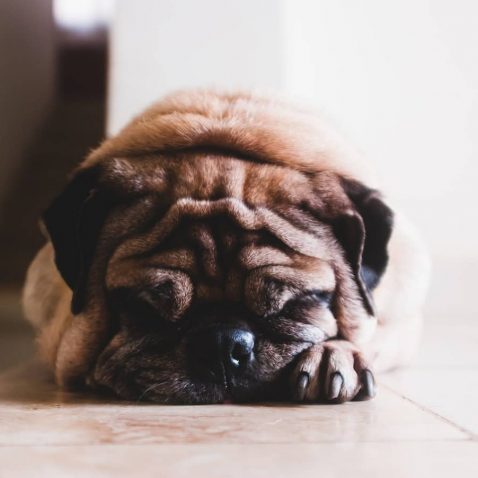
What Are The Main Symptoms of Dog Anxiety?
Anxiety can come with a heap of symptoms, so be sure to look out for any of these signs if you suspect anxiety in your dog.
Trembling
Trembling is one of the easier symptoms to spot. If your dog looks scared, it’s probably because he is. He may be shaking, with wide eyes and a furrowed brow.
Hiding
Anxious dogs will avoid people, situations, and other animals. This can show by either hiding behind furniture, leaving rooms that have people in, or hiding behind your legs.
Your dog may also try escaping to avoid situations.
Whining/ Whimpering
If your dog is whining or whimpering more than usual, and can’t be soothed, it could well be because of anxiety.
Excessive Barking
All dogs bark, but if your dog barks for no apparent reason, and you can’t soothe him, there’s a chance it may be anxiety.
Pacing
It can be hard to tell if your dog is pacing around the house out of boredom, or whether it’s anxiety-related. If they are pacing obsessively, it’s more likely to be a sign of anxiety.
Panting
It’s normal for dogs to pant, especially after a long walk or exercise. If your dog is panting when resting, it’s worth checking for other symptoms of anxiety.
Restlessness
Anxious dogs can sometimes show a boost of energy, such as running round in circles or jumping a lot. This may be excitement, but if he is displaying other symptoms of anxiety, then refer to Chapter 3 to see how you can help your anxious dog.
Destructive Behavior
Chewing can be a huge inconvenience, and an anxious dog may chew objects, doors, sofas – anything he can get his teeth into.
Anxious dogs may also dig into carpets, creating holes and damage to furniture.
Spontaneously Urinating/ pooping
Just like humans, dogs’ bodies have a sympathetic nervous system response which increases adrenaline – a by-product of this is the relaxation of the bladder and sphincter muscles, which basically means your dog may poop or wee himself when nervous or anxious.
All dogs may exhibit these symptoms, and it’s completely normal – but it becomes a problem when your dog is experiencing a few of these symptoms at once, or to the extreme.
How Can I Help My Anxious Dog?
There are methods you can use to soothe your dog in the short term, but for long term treatment, it’s always best to seek advice from your veterinarian.
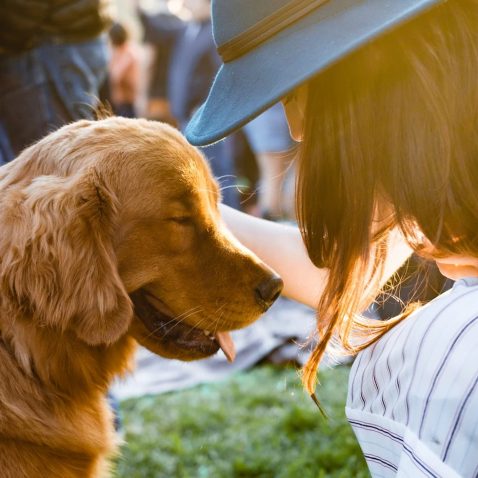
Play Calming Music
Much like humans, dogs can be calmed down by music.
Studies have shown that playing music in animal shelters reduces stress in dogs, and they show fewer anxiety symptoms.
This method works great if noise is the cause of your dog’s anxiety. For example, on bonfire night, it may help your dog if you put some calming music on that your dog can focus on. Even white noise will do the trick!
This can work even if your dog barks at noises outside – the white noise will mask the sound and allow your dog to relax without listening out for danger.
Soft rock and reggae are genres that are proven to help dogs relax, and are commonly played in dog shelters to calm down stressed dogs.
Dogs with separation anxiety may also benefit from the sound of music – especially when left home alone.
There are special sounds and songs available on the internet that are made to calm down your dog. There are playlists available on Spotify and Youtube.
Variety is key when using the music method to help your anxious dog. If you play the same sound over and over, he will get used to it and will become background noise – and begin to show anxiety symptoms again after some time.
Training
There are things you can do to train out certain behaviors. For example, separation anxiety is usually triggered when your dog realises you’re leaving.
Collect your keys, and get your coat on. Your dog will most likely start barking or showing other signs of anxiety. Don’t actually leave. Doing this repeatedly will desensitize your dog to these actions, and they’ll no longer trigger anxiety.
Once your dog starts feeling less anxious about you preparing to leave, then try actually leaving for a few minutes. Stand behind the door ask your dog to stay, and repeat, increasing the amount of time you’re gone each time.
Keep building up the amount of time you’re gone until your dog is used to you being gone.
If you can bring yourself to do this, when you return, don’t make it a big spectacle. Let your dog realize that it’s not a big deal that you were gone and that you are now home.
This method requires time and patience but is highly effective.
Give Your Dog Lots of Love
Some experts advise you not to reward fearful behavior, but a lot of experts advise the opposite – to soothe your dog when he’s anxious or scared. In nature, dogs look for safety with their packs – and we are their packs.
Stroking, or hugging your dog may help him calm down. This is a short term solution, and the problems may recur, but it’s a quick and friendly way to help your dog feel more secure.
Physical touch really does calm down dogs with anxiety and will help your dog stay calm in stressful situations. So next time you’re taking your dog to the vet, give him lots of affection to make the ordeal more bearable.
If you can’t always be there for your dog, then leave something that smells like you behind. A pillow you sleep with or your favorite t-shirt will do the trick. Your dog will most likely be comforted by the scent of you.
This method works well for separation anxiety – dogs have a great sense of smell, and something that smells like you is sure to relax them in your absence.
Seek Advice From a Professional
If your dog’s anxiety becomes unmanageable, or if you are worried about your dog, always get advice from your vet.
Some dog owners use CBD oil to treat their anxious dogs, although, as of yet, there is no proven scientific data to prove that this works.
Animal behaviorists are also great for helping dogs with anxiety, although they can charge steeply for their services.
A professional may put together a behavior plan to help you change your dog’s underlying emotional responses.
Your veterinarian may suggest medical treatment for your dog. There are sedatives and anti-anxiety medications available for dogs, but some experts suggest that they don’t treat anxiety, they just
mask the underlying problem.
Some medicines known to help anxious dogs include:
- Valium
- Fluoxetine
- Paxil
- Lorazepam
Sometimes, with medicines and tablets, the side effects can be worse than the symptoms. You should always get advice from a professional before giving your dog any medication.
Can Dog Anxiety Be Prevented?
There are things you can do for your puppy that will reduce the chances of him getting anxiety in later life. Although none of these are sure-fire ways, they all help prevent anxiety to some extent.

Exercise
Exercise is essential for all dogs, regardless of breed, size, or age. Exercise keeps your dog stimulated, and a stimulated dog is generally a happy dog.
If your dog is stimulated, he’s far less likely to pick up destructive behaviors that stem from anxiety.
Taking care of your dog’s physical needs is hugely important and detrimental to your dog’s mental health.
Regular walking also exposes your dog to new situations. A dog that is walked regularly will be less scared of other humans and other animals will react better when put in unfamiliar situations.
Walking your dog will also give you the chance to see what some of his triggers are. For example, if he gets anxious around other dogs, it’s easier to see this when he’s on a walk. Same with squirrels, cars, and various other things that can make a dog anxious.
Routine
A routine may be just what your dog needs. If your dog’s day is unpredictable, his stress levels are going to be higher than if he had a routine.
Dogs like predictability, it’s familiar, and the unexpected can stress him out.
Wake up, walks, feeding time, playtimes, and bedtimes should all be at similar times per day.
Adding new things to your dog’s routine is fine – spontaneous trips to the shop, vet appointments, etc are all fine as long as your dog’s core structure remains stable.
Exposure
Some dogs can get anxious in unfamiliar situations, and the best way of preventing this is by exposing them to these situations while they’re still developing.
The crucial time for a dog’s social development is 8-12 weeks. A lot of dogs have a fear of humans if they weren’t introduced to humans while they were still developing. If a puppy hasn’t met a human before he hits 12 weeks, he’s probably going to have difficulty bonding with humans in later life, and therefore feel anxious around them.
When dogs are still growing, they should also meet other animals. If a dog hasn’t had any form of relationship with another dog in younger life, he may experience anxiety around other dogs.
Taking your dog out when he’s at this crucial stage will be hugely beneficial to him in later life. Usually, puppies are around 8 weeks old when they go to their new home, which is the perfect age to introduce him to new experiences and people.
If your home is quiet, be sure your puppy gets the chance to meet new people like the postman, local children, and delivery drivers. This introduction at a young age will decrease the chance of him being scared of postmen in later life.
Summary
Dogs are sensitive creatures, and the way they’re treated can have detrimental effects on their wellbeing.
Knowing the causes, symptoms and how to help an anxious dog is hugely important. A lot of anxiety symptoms can be completely normal behaviors, but combined can be an indication of a bigger problem.
The key is to notice the symptoms of anxiety in dogs before they become problematic. Keeping a close relationship with your dog will make it easier to notice any changes your dog may be going through.
Many anxieties in dogs can stem from puppyhood, so you must take extra care of puppies and expose them to the world while they’re in that crucial stage.
Always get advice from your veterinarian or a dog expert if natural treatments and training aren’t managing your dog’s anxiety.
Do you have any tips for relieving dog anxiety? Let us know in the comments below, and don’t forget to share this with your fellow dog lovers.
Share the Love
If you found this post useful, please let others know about it by sharing it.
